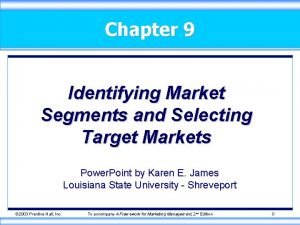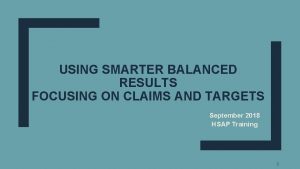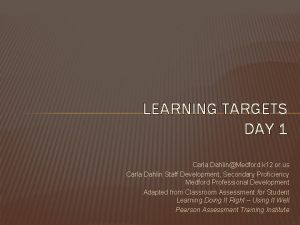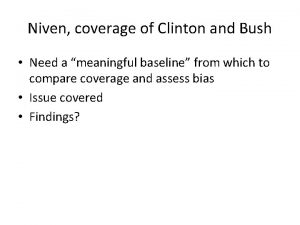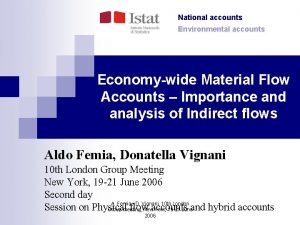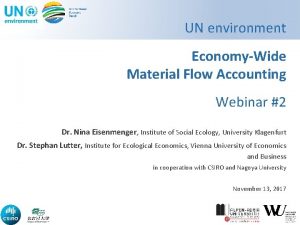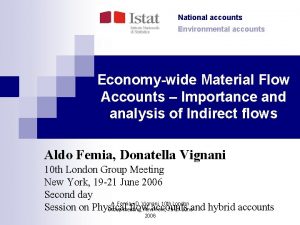Economywide modelling of climate targets and policies Niven


















- Slides: 18

Economy-wide modelling of climate targets and policies Niven Winchester

Climate change is ‘a man-made disaster of global scale’ and ‘our greatest threat in thousands of years’ Sir David Attenborough

Outline • Economy-wide policy modelling • New Zealand climate policy • The Climate Po. Licy ANalysis (CPLAN) model • Distributional impacts • Conclusions

Economy-wide Policy Modelling • Computable general equilibrium (CGE) models for climate policy analysis include: • • • Economic, energy and agricultural sectors and their interactions Greenhouse gas (GHG) emissions linked to activities New and emerging technologies ‘No free lunch’ constraints Climate and other policies • Built on national statistics, economic theory, and estimates of behavioural responses • Include ‘everything’ but are not ‘models of everything’

New Zealand Climate Policy • The Zero Carbon Act provides a framework for New Zealand to develop and implement climate change policies • The Act sets long-term targets for two baskets of greenhouse gases • Reduce biogenic methane by 24 -27% below the 2017 level by 2050 • Gross emissions equal removals by forestry (net zero) for other GHGs • Established an independent Climate Change Commission (CCC) • Contracted development of tools for climate policy analysis

The Climate Po. Licy ANalysis (CPLAN) Model • New Zealand-focused recursive-dynamic CGE model of economic activity and GHG emissions developed for the Climate Change Commission • Used to evaluate emission budgets and policies to meet New Zealand’s long-term climate goals • Builds on the Economic Projection and Policy Analysis (EPPA) model at the Massachusetts Institute of Technology. • Represents 36 sector, all greenhouse gases (CO 2 CH 4, N 2 O, F-gases) and new technologies • Informed by/linked to sectoral models • Linked to a distributional impacts module to evaluate impacts on subgroups

CPLAN sectors Agriculture Dairy farming Beef and sheep farming Other animal products Horticulture Forestry Fishing Energy extraction & distribution Crude oil extraction Refined oil products Coal extraction Natural gas extraction and distribution Coal electricity Gas electricity Hydroelectricity Wind electricity Solar electricity Geothermal electricity Electricity transmission and distribution Transport Road Transport Air transport Water transport Private transport Energy-intensive manufacturing Chemical, rubber & plastic products Cement manufacturing Non-ferrous metals (e. g. , aluminium) Iron and steel Other sectors Mining of metal ores Dairy products Meat products Other food processing Wood processing Paper and paper products Textiles, clothing and footwear Trade Construction 7 Services

Transpor t model Other policie s CPLA N Electricit y model Forestr y model Agricultural model

2014 emissions matrix, Mt. CO 2 e

Illustrative production function Abatement opportunities are represented by (1) substitution among fuels, and (2) substitution from fuels to capital-labor (price-induced energy efficiency improvements)

Emissions reduction options • Explicit technologies • • • EVs for private and commercial transport Methane-reducing technology for dairy, beef & sheep agriculture Biomass for process heat Electrification of process heat CCS for geothermal electricity • Fuel switching • Price-driven energy efficiency • Exogenous energy efficiency and emissions intensity improvements • Reducing output

25 20 15 10 GHGs (Mt. CO 2 e) 35 Biogenic methane 30 5 0 Policy Reference 20 22 20 24 20 26 20 28 20 30 20 32 20 34 20 36 20 38 20 40 20 42 20 44 20 46 20 48 20 50 GHGs (Mt. CO 2 e) Emission pathways to meet Zero Carbon Act targets 45 Other GHGs (net) 40 35 30 25 20 15 10 5 0 Policy Reference

Emission prices are reasonable… …. under the specified technology assumptions Biogenic methane emissions price 120 400 350 20 0 300 250 200 150 100 50 0 20 22 20 24 20 26 20 28 20 30 20 32 20 34 20 36 20 38 20 40 20 42 20 44 20 46 20 48 20 50 40 Carbon Price (NZ$/t. CO 2 e) 60 20 22 20 24 20 26 20 28 20 30 20 32 20 34 20 36 20 38 20 40 20 42 20 44 20 46 20 48 20 50 Carbon Price (NZ$/t. CO 2 e) 100 80 Other GHG emissions price

Large increases in wind and solar generation… and carbon capture and storage for geothermal electricity

Household transport is fully electrified and 65% of commercial road transport is electrified by 2050 Commercial electric road transport 90 80 70 60 50 40 30 20 10 0 Policy Reference 100 90 80 70 60 50 40 30 20 10 0 20 22 20 24 20 26 20 28 20 30 20 32 20 34 20 36 20 38 20 40 20 42 20 44 20 46 20 48 20 50 Percent of travel by electric vehciles 100 20 22 20 24 20 26 20 28 20 30 20 32 20 34 20 36 20 38 20 40 20 42 20 44 20 46 20 48 20 50 Percent of travel by electric vehciles Household electric road transport Policy Reference

Distributional Impacts • The Distribution Impacts Module – Employment (DIM-E) downscales results from CPLAN to estimate employment impacts for subgroups • Uses the Integrated Data Infrastructure CPLAN DIM-E Results Employment impacts for 36 sectors Employment impacts for ANZIC 3 -digit industries Worker characteristics by industry Employment impacts by subgroups (regions, income groups, ethnicity, age groups etc. )

Conclusions and next steps • CPLAN is a bespoke, New Zealand-focused CGE model for climate policy analysis • CPLAN can be linked with the DIM-E to estimate distributional impacts • Next steps • Document CPLAN and DIM-E (in progress) • Improve model functionality and expand climate policy modelling capacity in New Zealand (never ending)

Useful quotes • If we have data, let’s look at data. If all we have are opinions, let’s go with mine (Jim Barksdale) • If you torture the data enough, nature will always confess (Ronald Coase) • All models are wrong, some are useful (George Box) • The best we can do is ‘fail better’ (Samuel Beckett)
 Climate based daylight modelling
Climate based daylight modelling Climate change 2014 mitigation of climate change
Climate change 2014 mitigation of climate change Objectives of warehouse management system
Objectives of warehouse management system Identifying market segments and targets chapter 9
Identifying market segments and targets chapter 9 Identifying market segments and targets
Identifying market segments and targets Identifying market segments and targets chapter 9
Identifying market segments and targets chapter 9 Identifying market segments and targets
Identifying market segments and targets Identifying market segments and targets
Identifying market segments and targets Parathyroid gland chief cell
Parathyroid gland chief cell Smarter balanced claims and targets
Smarter balanced claims and targets Identifying market segments and targets
Identifying market segments and targets Writing learning targets
Writing learning targets Racial etiquette region
Racial etiquette region Brides magazine targets consumers who are in
Brides magazine targets consumers who are in Targets of change
Targets of change Smart pe gcse
Smart pe gcse Learning targets
Learning targets Forensic science learning targets
Forensic science learning targets Reasoning learning targets examples
Reasoning learning targets examples





